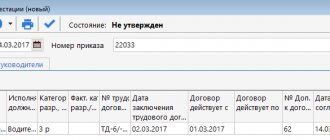according to the T-3 form
for 2022 due to salary increases
due to the introduction of new positions
The staffing table (SHR or in common parlance - “shtatka”) contains a list of structural units, names of positions, specialties, professions indicating qualifications and information on the number of positions (Decree of the State Statistics Committee dated January 5, 2004 No. 1). The same resolution also approved the recommended unified form No. T-3, which is installed in all personnel accounting software products and, as a rule, is used by organizations and entrepreneurs.
Making changes to the SR
Legislative norms have established why the staffing table is being changed:
- when introducing a new position or a new structural unit;
- when their name changes;
- when the salary or tariff rate changes;
- when eliminating vacant positions and departments;
- when reducing staff or numbers.
The law does not establish the number of such documents, nor specific deadlines or periods for correction. If you need to introduce a position in the ShR, then issue an order for changes. Innovations are given directly in the text of the document or presented as an appendix. The document is signed by the head of the organization or a person authorized by him. There is no unified form; the employer has the right to develop it independently. The main principle is to record all the adjustments made.
Effective period of the amended staffing table
Most often, the length of time between writing an order and making adjustments to the staffing table with its subsequent entry into force is not limited by anything, except when it comes to staff reduction.
In such situations, at least two months must pass between the writing of the order and the entry into force of the new staffing table.
During this time, the company's employees who have been laid off can decide on their future plans: either transfer to another vacant position within the company (if there is one) or look for a new place of work.
Introduction of new units
If an organization needs to introduce a new rate and hire a specialist whose position is not provided for in the staff, or add an entire division to the organization, then a separate order should be issued. The order contains information about the name of the structural unit, the name of the position, the number of rates, the form of remuneration (salary or tariff rate).
Sample order if a new position has been introduced into the organization’s staffing table.
Where to find the staffing table in ZUP 3.1 and how to work with it
find the Staffing table in the Personnel – Staffing table section:
The directory can be viewed in a hierarchical form, grouped by departments. The view is switched using the List View :
At the bottom of the form there are checkboxes:
- The Show unapproved positions checkbox enables the display of positions created in the directory, but not yet included in the current staffing table. These items are highlighted in bold in the list:
- The Show closed positions checkbox displays - enables the display of positions excluded from the current staffing table. They are highlighted in strikethrough font:
See also:
- Lifehacks for recording working time (from the recording of the broadcast dated October 1, 2022)
- Lifehacks for HR records (from the recording of the broadcast dated October 1, 2018)
Changing the title of a position or department
Renaming, as a rule, does not entail a correction in the labor function of an employee (or an entire department). If the job function changes, then renaming cannot be carried out. It is required to formalize the transfer of an employee (or several employees) to a new position. Changing the name will entail making adjustments and additions to the employment contract, the work book and the employee’s personal card. This is similar to making changes to the staffing table when introducing a new position or workplace, but instead of new units, the names of old ones are changed.
IMPORTANT!
Such innovations not only require notification, but also consent from employees. In case of refusal, the employer should be guided by Art. 74 of the Labor Code of the Russian Federation, without missing the mandatory notification to the employee two months before the adjustments.
ConsultantPlus experts examined whether an unscheduled special assessment of working conditions is carried out when changing the name of a position in the staffing table. Use these instructions for free.
to read.
How often can changes be made to the staffing table?
The law in no way regulates the frequency of making changes to the staffing table, so it all depends on the management of the organization. In principle, if desired, changes can be made at least every month (however, such activity may arouse interest from the labor inspectorate), but usually this happens much less frequently, once a year or as needed.
It is appropriate to edit staffing tables for minor changes in the overall activities of the enterprise.
But if we are talking about a global reorganization of structural units, staffing units, etc., then it is better not to limit ourselves to changes in the staffing table, but to draw up a new document.
Adjustment of salaries or tariff rates
This is a change in the terms of remuneration agreed in the employment contract. Consequently, an order in connection with a change in the structure and staffing table when increasing or decreasing the salary requires mandatory agreement with the employee. In case of refusal of the employee, the employer should be guided by Art. 74 Labor Code of the Russian Federation.
Rationale
The current labor legislation does not directly regulate this issue, while there is no direct prohibition on changing the work schedule for employees with cumulative accounting of working hours during the accounting period. Official explanations from government agencies are not provided in SPS ConsultantPlus.
At the same time, in order to make a decision in this matter, the employer must take into account that the shift work schedule should be distinguished from the regular schedule (not shift work).
Extracted from the HR Guide. Work time
2.2. Work schedule with summarized recording of working hours
When recording working hours in aggregate, the presence of a work schedule is mandatory, since the employee must know in advance what his work schedule will be (for example, a sliding schedule in flexible working hours). It is necessary to distinguish the shift schedule for the corresponding work from other work schedules, the use of which is associated with the introduction of summarized recording of working hours (for example, when working in one shift). For more information on creating a shift schedule, see paragraph 5 of this material.
The work schedule can be put into effect by order of the head of the organization. The Labor Code of the Russian Federation does not contain norms defining the period and form of familiarization with work schedules, in which a summarized recording of working time is also introduced, in contrast to the shift schedule (Part 4 of Article 103 of the Labor Code of the Russian Federation). Therefore, in the PVTR, when determining the procedure for introducing summarized recording of working time, it is advisable to establish a procedure for familiarizing yourself with the specified schedule.
If the employee refuses to sign to confirm familiarization with the work schedule, the employer should draw up a corresponding report.
5.1. How to draw up a shift work schedule, including when recording working hours summed up
Shift schedules are drawn up taking into account the opinion of the representative body of workers in the manner established by Art. 372 of the Labor Code of the Russian Federation (Part 3 of Article 103 of the Labor Code of the Russian Federation).
For more information, see the HR Guide. Trade union."
The schedules are drawn up based on the established norm of working time for the accounting period for a specific category of workers and contain information about the duration of working time during a shift, rest breaks between shifts and the order of their rotation.
After drawing up the shift schedule must be approved by the head of the organization. As a general rule, the schedule is put into effect by issuing an appropriate order.
Employees must be familiarized with the approved shift schedule by signature at least a month before it comes into force (Part 4 of Article 103 of the Labor Code of the Russian Federation). If one of the employees refuses to become familiar, the employer should draw up a corresponding report.
How to notify about a change in work schedule
If employees working as usual, at the initiative of the employer, need to change the work mode (for example, when switching from a two-shift to a three-shift mode), employees are notified of this at least two months in advance (Article 74 of the Labor Code of the Russian Federation). If they agree to work under changed conditions, additional agreements to the employment contract are concluded with them.
In the case of transfer of an employee to a position or work where a shift schedule is provided, the change in conditions does not require two months’ notice. A transfer to another job is formalized by signing an additional agreement on changing the work schedule (Article 72 of the Labor Code of the Russian Federation). In this case, the employee must be familiarized with the local regulations governing work according to the shift schedule, and directly with the schedule.
How to notify about a change in work schedule
If employees working as usual, at the initiative of the employer, need to change the work mode (for example, when switching from a two-shift to a three-shift mode), employees are notified of this at least two months in advance (Article 74 of the Labor Code of the Russian Federation). If they agree to work under changed conditions, additional agreements to the employment contract are concluded with them.
In the case of transfer of an employee to a position or work where a shift schedule is provided, the change in conditions does not require two months’ notice. A transfer to another job is formalized by signing an additional agreement on changing the work schedule (Article 72 of the Labor Code of the Russian Federation). In this case, the employee must be familiarized with the local regulations governing work according to the shift schedule, and directly with the schedule.
Ready-made solution: How can an employer make changes to the shift schedule (ConsultantPlus, 2021)
We recommend making changes in the same way as you approved the original shift schedule; the procedure is not regulated by law. In practice, they still issue an order to make changes to the schedule. For changes that do not change the terms of employment contracts, it is usually necessary to take into account the opinion of the representative body of employees and approve the changes. If the conditions change, then enter into additional agreements to the employment contracts with the shift workers who agree, and change the work schedule for those who disagree according to a special procedure.
Changes can be formalized by drawing up a schedule in a new edition or by drawing up a separate document.
It is necessary to change the internal labor regulations if changes to the shift schedule affect their provisions.
How to draw up an order to change the shift schedule
Draw up an order to change the shift schedule in any form, since there is no normatively approved one. The document is optional, but it is often drawn up in practice to begin the procedure for making changes to the shift schedule.
We recommend specifying in the order, in particular:
- the reason for its publication;
- information about schedule changes. Here, indicate directly the changes that you plan to introduce;
- information about employees (positions, full names, structural units) affected by the changes;
- instructions to responsible persons. For example, a HR specialist should prepare a draft schedule change.
Introduce the order to change the shift schedule to the responsible employees against their signature.
How to change the shift schedule if the changes do not affect the terms of the shift workers’ employment contracts
The procedure for making changes to the shift schedule in this case is not regulated by law. We recommend making changes in the same order in which you approved the original shift schedule. This approach is applied in practice and is risk-free.
We recommend doing the following:
- prepare the changes (we’ll tell you how to prepare them below);
- take into account the opinion of the employee representative body (if you have one). We advise you to take this opinion into account, since it is required when approving the shift schedule (Part 3 of Article 103 of the Labor Code of the Russian Federation);
- approve the changes in the same order as the original shift schedule. For example, if the original shift schedule was approved by order of the director of the organization, then the changes must be approved by order of the director. This must be done in advance in order to have time to familiarize shift workers with the changes, usually at least a month in advance (Part 4 of Article 103 of the Labor Code of the Russian Federation).
If the shift schedule is an annex to the collective agreement, we recommend that you consider the following. If the collective agreement does not stipulate the procedure for changing the shift schedule, then change it in the same way as the collective agreement. That is, before changing the schedule, conduct collective negotiations on this issue. When the changes are accepted, send the amended document for notification registration to the labor authority in accordance with Part 1 of Art. 50 of the Labor Code of the Russian Federation (Article 36, Part 3 of Article 103 of the Labor Code of the Russian Federation).
2.1. How to formalize changes to the shift schedule
The form of changes to the shift schedule is not normatively established. In practice, two methods are used. The first method is that the shift schedule is drawn up in a new edition (this is convenient if the changes affect all shift workers).
The second method is to draw up a separate document (addition to the schedule). This is convenient when changes affect only a part of the employees. For example, if you change shifts between two shift workers out of six, or change the work mode of only one shift worker. You can take your shift schedule form as a basis and indicate only the information that you are changing.
An example of registration of changes to the shift schedule as a separate document (as an addition to the schedule)
Department settings
We create organizational divisions in the “Settings/Divisions” section.
Fig. 8 Forming divisions of the organization
Let's look at the subdivision display window.
Fig.9 Window for displaying units
At the top of it is the “Organization” field. If you check the box and select the organization you are interested in, the list will include only its departments. For convenience, the list of departments can be set to three viewing modes by clicking “More”:
- The “Hierarchical List” will not display all departments, but only the selected ones and those that are higher in the hierarchy.
- “List” will display all departments in a row, without showing nesting in higher ones;
- The most convenient option is “Tree”, which shows all the departments and where they are nested.
Fig. 10 The list of departments can be set to three viewing modes
Let's set up 1C:ZUP for the correct formation of the staffing table
What is staffing
This is a document that describes in detail the entire structure of the organization: divisions, departments and positions assigned to them.
Most often, the schedule is drawn up even before the company is created - this is a visual design of how the work will be organized, which specialists will be involved in it and what their job responsibilities will be.
The Labor Code does not directly say anywhere that the staffing table is legally required, but in Article 15 it is mentioned as one of the elements of the concept of labor relations: if an employee is employed in any position, then there must be a structured list of all positions.
And Article 57 of the Labor Code of the Russian Federation states that when concluding an employment contract, it is imperative to indicate the function that the specialist will perform “in accordance with the staffing schedule.”
Therefore, staffing is mandatory.











